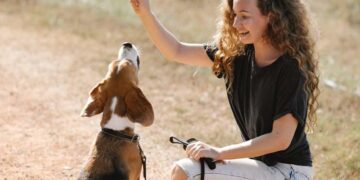Table of Contents
Introduction: The Unspoken Struggle of a Problem Pup
The moment the world shrinks to the size of your living room, you know you have a problem. For the author and a rescue dog named Leo, that moment came on a Tuesday. A dropped piece of toast, a low growl that rumbled up from a place of pure instinct, and suddenly the familiar comfort of home was charged with a new, unwelcome current of fear. This wasn’t the first sign. The daily walks had already become a source of dread, a tense ballet of avoiding other dogs, skateboards, and friendly neighbors whose outstretched hands could trigger a frenzy of lunging and barking.1 Every jingle of a leash was a prelude to anxiety, both his and the owner’s. The house was littered with the evidence of his distress: a chewed-up door frame, the stuffing pulled from a new cushion, silent monuments to separation anxiety.3 Leo was a good dog, a loving dog, but he was also a dog living in a state of constant, unmanageable stress, and he was pulling his human family into that state with him.
This experience—the cocktail of love, frustration, embarrassment, and a creeping sense of failure—is an unspoken secret shared by countless dog owners. It is the quiet closing of the blinds when a dog barks incessantly at passersby, the hasty apologies on the trail, the feeling of isolation when friends with “easy” dogs can’t understand the daily struggle.5 It is the exhausting search for answers in a world saturated with conflicting advice, a world where every other person is an amateur trainer and every website promises a miracle cure. This report is for those owners. It is born from that same place of desperation but is written from the other side—a place of understanding, success, and a renewed, peaceful partnership with a once-troubled dog.
The journey from chaos to calm is not about finding a magic wand; it is about finding the right guide. The dog training industry can be a bewildering landscape of competing philosophies, flashy marketing, and jargon that obscures more than it clarifies. This report serves as a detailed map and a trusted compass for navigating that landscape in Austin, Texas. It will cut through the noise by first establishing a clear, evidence-based understanding of modern dog training principles. It will then use that framework to meticulously evaluate the area’s most prominent training camps and programs. The goal is to move beyond the question of “what works” and ask the more important questions: “What works humanely?”, “What builds trust?”, and “What creates lasting change that strengthens, rather than damages, the bond with your dog?” This is a roadmap from the end of your leash to a new beginning.
Chapter 1: The Fork in the Road: Understanding the Two Worlds of Dog Training
Before evaluating a single Austin facility, it is imperative to understand the fundamental philosophies that govern the dog training profession. This is not a minor detail; the methodology a trainer employs will shape your dog’s emotional state, its perception of the world, and the very foundation of your relationship. Choosing a trainer is choosing an entire educational and ethical framework. This chapter will provide the critical knowledge needed to become a discerning consumer, capable of distinguishing between modern, science-backed practices and outdated, potentially harmful methods.
The Science of Connection – Humane, Modern Training
The term “science-based” has become a popular marketing buzzword, but at its core, it refers to a training approach grounded in the principles of animal behavior and learning theory.6 This modern approach focuses on understanding how dogs think, learn, and communicate, and it uses that knowledge to foster a cooperative partnership. It is not about being “permissive”; it is about being a more effective and humane teacher.
At the heart of this methodology are two key principles of learning theory: classical and operant conditioning.7 Classical conditioning is about associations. It is the reason your dog gets excited at the jingle of a leash or the opening of a treat jar; they have learned that one thing predicts another.7 Trainers leverage this by, for example, pairing a scary stimulus (like another dog) with something wonderful (a high-value treat), gradually changing the dog’s emotional response from fear to happy anticipation—a process known as counter-conditioning.8
Operant conditioning, meanwhile, is about consequences. It posits that behaviors that are reinforced are more likely to be repeated.7 The cornerstone of modern, humane training is a specific quadrant of operant conditioning called
positive reinforcement.9 In the context of training, “positive” does not mean “good”; it is used in a mathematical sense, meaning to
add something. “Reinforcement” means to increase a behavior.10 Therefore, positive reinforcement is the practice of adding something the dog values (a treat, a toy, praise) immediately after a desired behavior occurs, making that behavior more likely to happen in the future.6 A simple analogy is a paycheck: most people go to work because they are paid for their efforts. The paycheck reinforces the behavior of working. For a dog, a food reward is a paycheck for a job well done.12
This approach is about more than just teaching “sit” or “stay.” It is a holistic philosophy that builds a stronger bond based on trust and mutual understanding. The owner becomes a supportive guide who sets the dog up for success, rather than a disciplinarian who waits for mistakes to punish.6 A crucial advantage of this method is its focus on addressing the root cause of a behavior. A dog that lunges and barks at other dogs is often not being “dominant” or “stubborn”; it is usually acting out of fear or frustration.1 A modern trainer seeks to understand and change that underlying emotional state, teaching the dog to feel safe and confident in the presence of other dogs, which in turn eliminates the need for the reactive behavior.6
The “Balanced” Approach and the Tools of Correction
Another prevalent philosophy is “balanced training.” Proponents of this method state that it uses techniques from across the spectrum of learning theory—employing positive reinforcement for desired behaviors while also using corrections, or punishment, for undesired behaviors.10 This approach is often marketed as a common-sense way to provide both clear rewards and clear boundaries.
The “correction” side of the balanced training equation involves the use of aversive tools designed to stop a behavior by causing physical discomfort or pain. The most common of these tools are prong collars (also called pinch collars), choke chains, and electronic collars (also known as e-collars or shock collars).11 These tools function through the principle of
positive punishment. Again, using the mathematical definition, “positive” means to add something, and “punishment” means to decrease a behavior.10 When a dog wearing a prong collar pulls on the leash, the prongs tighten and press into its neck, adding an unpleasant sensation (a punishment) that is intended to make the behavior of pulling less likely in the future. Similarly, an electronic collar adds an electrical stimulation to stop a behavior like barking or to enforce a recall command.13
Often intertwined with this methodology is the outdated concept of “dominance” or the need to be the “alpha” or “pack leader.” This theory, which suggests that dogs are in a constant struggle for social rank and that unwanted behaviors are an attempt to dominate the owner, has been thoroughly debunked by modern animal behaviorists. The American College of Veterinary Behaviorists (ACVB) states that this concept is based on a flawed interpretation of wolf behavior that has since been revised.16 They assert that a dog’s aggression toward a person is highly unlikely to be motivated by an attempt to establish dominance; rather, fear and conflict are far more probable causes. Applying this misinterpretation is considered counterproductive and often harmful, as it can lead to confrontational techniques that escalate a dog’s fear and anxiety, potentially making aggression worse.16
A Verdict from the Experts – The Professional Standard of Care
Given these two distinct philosophical paths, dog owners are left to wonder which is truly best. Fortunately, the world’s leading experts in veterinary medicine and animal behavior have provided a clear and unambiguous answer. The consensus from organizations like the American Veterinary Society of Animal Behavior (AVSAB) and the American College of Veterinary Behaviorists (ACVB) establishes a definitive, evidence-based standard of care.
In their 2021 Humane Dog Training Position Statement, the AVSAB makes its stance unequivocal. Based on current scientific evidence, they recommend that only reward-based training methods should be used for all dog training, including the treatment of complex behavior problems.18 They explicitly state, “There is no evidence that aversive training is necessary for dog training or behavior modification”.18
The AVSAB’s position is not based on opinion, but on a large body of scientific research that documents the significant adverse effects of aversive training methods. Studies show that training with tools like shock collars is stressful and detrimental to a dog’s relationship with its owner.13 Dogs trained with aversive methods exhibit more stress-related behaviors (like panting and yawning), have higher levels of the stress hormone cortisol, and show a higher incidence of both fear-related behaviors and aggression.13 The AVSAB warns that punishment can suppress a dog’s warning signals, such as growling or snarling. While this may seem like a “fix,” it does not address the underlying fear or anxiety. This can create a dangerous situation where a dog bites with little or no warning.11 For these reasons, the AVSAB’s position is that aversive methods “should not be used in canine training or for the treatment of behavioral disorders”.18
This expert consensus creates a powerful lens through which to evaluate trainers. Some trainers who use aversive tools may attempt to justify their methods by claiming they are “science-based,” noting correctly that punishment is one of the four quadrants of operant conditioning.10 This argument, however, is a narrow and misleading interpretation of science. While punishment is a recognized principle of learning theory, this does not mean its application is advisable, ethical, or safe. It is akin to acknowledging that physical force can stop a child from misbehaving, while ignoring the vast body of psychological research on the long-term emotional and developmental damage such methods can cause. A truly science-based approach considers not just the immediate effect on behavior but also the broader scientific understanding of animal welfare, ethology (the study of animal behavior), and the neurobiology of stress and fear. The organized scientific and veterinary community has weighed all this evidence and concluded that the risks associated with aversive tools far outweigh any perceived benefits.16 Therefore, the critical question for a dog owner is not, “Is this a scientific principle?” but rather, “Is this the humane, safe, and recommended application of science according to veterinary behavior experts?”
Furthermore, it is essential to acknowledge the emotional state of an owner struggling with a difficult dog. The daily stress and desperation can make the promises of a “quick fix” incredibly alluring. The marketing for many correction-based programs often features dramatic before-and-after videos and testimonials from relieved owners who saw rapid changes in their dogs’ behavior.6 This taps directly into the owner’s deep desire for immediate relief. In contrast, positive reinforcement training is a process of changing underlying emotions and building new skills, which can take more time and patience. This presents a difficult choice: the promise of a fast, but potentially harmful, solution versus a more gradual, humane, and relationship-building one. The decision a dog owner makes at this fork in the road has profound and lasting consequences for their dog’s well-being and the future of their partnership.
Chapter 2: Austin’s Training Landscape: A Guided Tour of the Top Contenders
Armed with a clear understanding of the expert-endorsed standard of care, it is now possible to evaluate Austin’s training facilities with a critical eye. This analysis will move beyond marketing claims to assess each contender based on their stated philosophy, program structure, trainer credentials, and the unfiltered feedback of their clientele. The facilities are grouped by their primary training model and their adherence to humane, evidence-based principles.
The Gold Standard in Humane Training (Top Recommendations)
These facilities represent the highest standard of modern, humane dog training in Austin. They explicitly commit to positive reinforcement methods, align with the AVSAB’s position statements, and focus on building a strong, cooperative relationship between dog and owner.
Every Dog Behavior and Training
- Profile: Every Dog Behavior and Training stands out as the premier choice for owners seeking to solve complex behavioral issues through a partnership-based, educational approach. As a nonprofit organization, its mission is to provide “inclusive, accessible, professional, ethical dog training and behavior support” to the entire Austin community.21
- Methodology: Their philosophy is unambiguous and directly aligns with the AVSAB gold standard. They state, “All of our trainers use positive reinforcement methods. You won’t find any shock collars or prong collars here”.21 This explicit commitment to force-free training provides clients with a guarantee of humane treatment.
- Credentials: The organization demonstrates a deep commitment to professional education. Their trainers are either certified or actively working toward certification with nationally recognized credentials, such as the Karen Pryor Academy (KPA), a highly respected institution in the world of positive reinforcement training.21
- Programs: Every Dog offers a comprehensive suite of services tailored to a variety of needs, including group classes for manners, puppy development, and specialty topics like agility. Crucially, they offer classes specifically for fearful and reactive dogs, as well as private behavior consulting for issues like separation anxiety.21 This range allows for customized solutions rather than a one-size-fits-all approach. It is important to note they do not offer a board-and-train program, as their philosophy is centered on owner involvement.21
- Client Feedback: Independent reviews are overwhelmingly positive. Reddit users recommend them as “science-backed” and highly effective for challenging issues like reactivity.24 One client testimonial on their website highlights a particularly powerful experience: after a failed and upsetting experience with a different $1,000 training program that used a collar without consent, they felt hopeless. After a six-week course at Every Dog, they felt they had the tools to make life easier for both them and their dog.21
- Unique Factor: Their nonprofit status is a significant differentiator. It underscores a mission-driven focus on animal welfare and community education over profit, which is further supported by a financial assistance program designed to make quality training accessible to everyone.21
The Dog Alliance
- Profile: Located in Cedar Park and serving the greater Austin area, The Dog Alliance is a world-class center of excellence. While renowned for its specialized work in training service and therapy dogs, the high standards and principles that guide these programs permeate all of their training for family pets.25
- Methodology: The Dog Alliance is explicitly committed to modern, humane methods. Their website states they use a “positive reinforcement approach” and are dedicated to creating a “fear-free environment” where dogs feel safe, comfortable, and loved.25 This philosophy is in perfect alignment with the AVSAB’s recommendations.
- Credentials: This facility boasts one of the highest levels of accreditation in the world as one of only 145 fully accredited members of Assistance Dogs International (ADI).25 This is a rigorous standard that speaks to an exceptional level of professionalism and ethical conduct. Their trainers hold numerous certifications, including Certified Professional Dog Trainer – Knowledge Assessed (CPDT-KA) and AKC Evaluator, and participate in yearly continuing education.25
- Programs: They offer a vast and impressive array of classes, from puppy manners and basic obedience to advanced dog sports like agility, nose work, and rally.25 Their specialized programs for training therapy dogs and providing service dogs to veterans with PTSD are a cornerstone of their community mission.25
- Client Feedback: Testimonials are glowing, with clients consistently praising the patient, knowledgeable, and caring trainers. Reviews highlight the “amazing” training approach, the welcoming environment, and the beautiful, clean, and well-equipped facility.25
- Unique Factor: The ADI accreditation is a powerful indicator of quality. It signifies adherence to the highest international standards for training assistance dogs, a discipline that requires an incredibly nuanced understanding of behavior, learning theory, and the human-animal bond. This expertise informs their entire training culture, benefiting every dog and owner who walks through their doors.
The Immersion Experience: An In-Depth Analysis of Board-and-Train Camps
Board-and-train programs, often called “doggy bootcamps,” are a popular option for owners seeking an intensive, immersive solution. In this model, the dog lives at the facility for a period of weeks while undergoing daily training. The following Austin facilities specialize in this model, but they vary dramatically in their transparency and methodology.
Taurus Academy
- Profile: Taurus Academy is a long-standing and well-regarded Austin institution, having won the “Best of Austin” award from the Austin Chronicle for eight consecutive years.30 With six locations, they are a major player in the local pet care scene, and their “Doggy Bootcamp” board-and-train program is a popular offering.30
- Methodology: This is where careful analysis is required. Taurus Academy’s website states they have a “large toolbox of Dog Training Techniques” and that while they “certainly utilize the most gentle, positive, and effective methods,” every staff member is a trainer.30 This language is intentionally broad. Unlike Every Dog or The Dog Alliance, there is no explicit commitment to being exclusively “force-free” or a promise not to use aversive tools. This ambiguity places the burden on the consumer to ask pointed questions about what specific tools are in that “toolbox” and under what circumstances they are used.
- Program Structure: The 2-, 3-, and 4-week board-and-train programs are comprehensive. They include a mandatory evaluation day, all boarding fees, daily training sessions, and trainer-assisted socialization.30 A key feature is the extensive owner handover process, which consists of four private lessons: one at the facility, two in the owner’s home, and a final one in a public place. This structure shows a strong understanding of the need to transfer skills to the owner in real-world environments.30
- Client Feedback: Reviews are largely positive. Clients praise the results of the board-and-train program, the caring staff, and the daily report cards with photos that keep them connected to their dogs.32 However, a deeper dive into Reddit discussions reveals a more nuanced picture. Some users have pointed out that certain locations, like the one on South Lamar, are older and more cramped than newer facilities like Bark & Zoom.34 Others have noted that the staff can be very young, which could imply a potential for inconsistency in skill and experience.34
Bobbi Colorado’s Canine Camp
- Profile: Established in 2004, Bobbi Colorado’s Canine Camp is a locally-owned facility that offers boarding, daycare, and training in a setting with large, tree-shaded play yards.36
- Methodology: The facility’s website is notably lacking in transparency regarding their training philosophy. It simply states that their “expert trainers will work closely with your dog on obedience and appropriate behaviors”.36 There is no mention of positive reinforcement, force-free methods, or any specific learning theory. This absence of information is a significant concern for any owner seeking to make an informed decision based on the AVSAB’s guidelines.
- Program Structure: They offer a 2-week board-and-train for $1,695 and a 4-week program for $2,395.36 These programs include boarding, training treats, a bath, and two follow-up lessons: a “go-home” lesson at pickup and one follow-up lesson in the owner’s home or another location.36
- Client Feedback: The reviews featured on their own website are positive, with clients emphasizing the caring environment and noting that their dogs get excited when they arrive at the facility.36 However, the provided research contains a lack of independent, third-party reviews, making it difficult to form a complete picture of the client experience.
ATX K9 Dog Training
- Profile: ATX K9 is a facility that specializes in board-and-train programs and is remarkably transparent about its training philosophy, which places it in direct opposition to the AVSAB’s recommendations.
- Methodology: They explicitly identify themselves as “balanced trainers”.14 Their website states, “…we believe that dogs must certainly hear that they are doing things correctly (and often!), but they must also be made aware when they are acting inappropriately”.14 They are equally transparent about their tools, listing them as including treats, clickers, martingale collars,
prong collars, and/or remote collars.14 This clear embrace of aversive tools is a critical differentiator. - Program Structure: They offer 1- to 4-week board-and-train programs that take place in a home-like environment, with the owners living on-site.14 Their materials emphasize that the owner’s commitment to follow-through is essential for lasting success, noting that if owners don’t do their “homework,” they won’t see progress.14
- Client Feedback: This is where the most significant conflict arises for a prospective client. The testimonials for ATX K9 are overwhelmingly positive, emotional, and compelling. Clients describe the results as “life-changing” and “amazing,” particularly for dogs with severe behavioral issues like reactivity, social anxiety, and a lack of manners.20 Owners of rescue dogs with traumatic histories praise the trainers for giving them a “solid foundation” and helping them finally bond with their dogs.20 This creates a powerful cognitive dissonance: the methods (prong and e-collars) are precisely what veterinary behavior experts warn against due to risks of increased fear and aggression, yet the client-reported outcomes are framed as overwhelmingly successful. This forces a potential customer to weigh the anecdotal evidence of satisfied clients against the data-driven consensus of the scientific community. It highlights that aversive tools
can suppress unwanted behavior quickly, leading to positive reviews from owners desperate for relief, but it leaves unaddressed the potential for long-term emotional fallout that the AVSAB warns about.
The Partnership Model: Building Skills Together
This category includes facilities that focus on owner-involved training, where the primary goal is to teach the human how to communicate with and train their own dog. These programs do not typically offer board-and-train options.
Zoom Room
- Profile: Zoom Room is a national franchise with an Austin location that offers training in an indoor, climate-controlled gym setting. Their model is explicitly focused on the owner-dog partnership.40
- Methodology: They are clear in their commitment to humane methods, stating they use only positive reinforcement.40 Their guiding philosophy is, “we don’t train dogs. We train the people who love them”.40
- Programs: They offer a wide variety of group classes that go beyond basic obedience, including agility, dog tricks, scent work, and puppy preschool.40 They also offer private gym rentals for off-leash play. They do not offer a board-and-train program.41
- Client Feedback: Testimonials on their website are positive, with clients praising the fun, energetic environment and the helpful, encouraging trainers.42 However, independent reviews on platforms like Reddit offer a more critical perspective. Some users have found the franchise to be overpriced and have noted that the trainers, while nice, may lack the depth of experience needed to handle serious, complex behavioral problems like fear and reactivity.43 One user explicitly advised another to “steer clear” of Zoom Room for real-world issues, stating that the indoor-only facility was not helpful for their dog’s reactivity to squirrels on walks.24
- Best Fit: Based on this feedback, Zoom Room appears to be an excellent choice for puppy socialization, building basic manners, and engaging in fun, sporty activities like agility in a controlled environment. However, for dogs with more severe, context-specific behavioral challenges like fear-based aggression or leash reactivity, a program with a stronger focus on behavior modification, like those offered by Every Dog or The Dog Alliance, may be more appropriate.
Finally, it is worth noting that the “board-and-train” model itself, while appealing, can be a double-edged sword. It is often marketed as a way to “fix” a dog, but the reality is more complex. A dog’s behavior is highly dependent on its environment and its handler. When a dog spends weeks learning from a professional trainer, it builds a relationship and learns to respond to that specific person’s timing, cues, and consistency. The most critical, and often most difficult, part of the program is the transfer of those skills to the owner. As ATX K9’s own materials suggest, if the owner is not able to perfectly replicate the trainer’s methods and maintain the structure at home, the dog is likely to regress.14 If the training involved aversive tools, the owner is now tasked with using equipment that can cause pain and may be difficult to use correctly, potentially creating new problems or damaging their bond with their dog. Therefore, a board-and-train should not be seen as a passive solution, but as an intensive program that teaches the dog a new language and then requires the owner to commit to becoming fluent in it.
Chapter 3: The Ultimate Decision-Making Guide
The information presented can feel overwhelming. This final chapter synthesizes the report’s findings into a practical, actionable toolkit. It is designed to empower any dog owner to move forward with clarity and confidence, armed with the ability to critically evaluate any training professional and make the best possible choice for their canine companion.
Your Pre-Enrollment Checklist: 10 Critical Questions to Ask Any Trainer
Before committing to any program or trainer, it is essential to conduct a thorough interview. The answers to these questions will reveal a trainer’s true philosophy, ethics, and expertise, cutting through marketing language to the core of their practice.
- “What specific training methods and philosophies do you follow?”
- Listen for key phrases. “Positive reinforcement,” “force-free,” and “science-based” are green lights. Be wary of vague answers like “a balanced approach” or “we use a variety of tools” without further clarification.
- “What specific tools will you use on my dog? Can you show them to me and explain exactly how they work?”
- This is non-negotiable. Ask to see and handle any collars, leashes, or other equipment. If they mention prong collars, choke chains, or electronic collars, you know their methods conflict with AVSAB recommendations.14
- “What happens when my dog gets a behavior ‘right’?”
- The answer should be centered on positive reinforcement: the dog is rewarded with something it values, like a treat, praise, a toy, or the opportunity to do something it enjoys.6
- “What happens when my dog gets a behavior ‘wrong’ or doesn’t respond to a cue?”
- A modern, humane trainer will talk about managing the environment to prevent the mistake, trying again, or breaking the task down into smaller, easier steps. A red flag is an answer that focuses on a physical or verbal correction or punishment.11
- “How do you address behaviors rooted in fear, anxiety, or aggression?”
- The answer should focus on changing the dog’s underlying emotional response through methods like counter-conditioning and desensitization. It should not be about suppressing the behavior through force or intimidation.2
- “What are your credentials, certifications, and what continuing education do you participate in?”
- Look for certifications from independent organizations like the Certification Council for Professional Dog Trainers (CCPDT) or the Karen Pryor Academy (KPA).23 A commitment to ongoing education is the mark of a true professional.
- “How do you align with the AVSAB’s position statements on humane training and the use of punishment?”
- This is a direct test of their knowledge and professional alignment. A well-educated, modern trainer will be familiar with these statements and should be able to discuss them intelligently. A trainer who dismisses them is demonstrating a disregard for the veterinary behaviorist community’s consensus.19
- “Can I observe a training class or session before enrolling?”
- Transparency is key. A confident, professional trainer should have nothing to hide and should welcome observation. A refusal is a major red flag.
- (For Board-and-Train) “What does a typical day look like for my dog in your program?”
- Ask about the number of training sessions, the amount of enrichment and playtime, rest periods, and how much time is spent in a kennel.
- (For Board-and-Train) “What is your client ‘handover’ process, and what kind of follow-up support do you provide?”
- As discussed, this is the most critical part of the program. Look for a detailed plan that involves multiple, hands-on sessions with you and your dog in various environments to ensure you can maintain the training.30
Austin Dog Training Camps at a Glance
This table provides a summary of the key facilities analyzed in this report, allowing for a quick comparison based on the most critical decision-making factors.
| Facility Name | Primary Training Model | Stated Methodology | Uses Aversive Tools (Prong/Choke/Shock)? | Trainer Credentials Mentioned? | Best Suited For… |
| Every Dog Behavior and Training | Private Lessons, Group Classes | “Positive Reinforcement methods” 21 | No 21 | Yes (Certified or working towards national credentials like KPA) 21 | Owners seeking to solve complex behavioral issues (fear, reactivity) through a humane, partnership-based approach. |
| The Dog Alliance | Private Lessons, Group Classes | “Positive reinforcement,” “fear-free” 25 | No 25 | Yes (ADI Accredited, CPDT-KA, AKC Evaluator) 25 | Owners seeking the highest standard of training for pets, sports, or therapy/service work in a world-class facility. |
| Taurus Academy | Board-and-Train, Daycare | “Large toolbox,” “gentle, positive” methods 30 | Unspecified/Vague | No | Owners seeking an intensive board-and-train program with a robust owner handover process, but who must clarify the specific tools used. |
| Bobbi Colorado’s Canine Camp | Board-and-Train, Daycare | “Work on obedience and appropriate behaviors” 36 | Unspecified/Vague | Yes (“Certified dog trainers”) 36 | Owners comfortable with a facility that is not transparent about its training methodology online. |
| ATX K9 Dog Training | Board-and-Train | “Balanced trainers” 14 | Yes (Prong and/or remote collars) 14 | No | Owners seeking fast results for severe behaviors and who are comfortable with the use of aversive tools, contrary to AVSAB recommendations. |
| Zoom Room | Group Classes, Private Lessons | “Only positive reinforcement” 40 | No 40 | Yes (AKC Evaluators) 40 | Puppy socialization, basic manners, and fun dog sports like agility in a controlled, owner-involved setting. |
Red Flags and Green Lights
As a final guide, keep these simple heuristics in mind during your search. They can help you quickly assess whether a trainer’s philosophy aligns with modern, humane standards.
Red Flags 🚩
- Dominance Language: Any mention of being the “alpha,” “pack leader,” or the need to establish “dominance” over your dog. This is based on debunked science and encourages a confrontational relationship.16
- Guaranteed Results: Behavior is complex and never 100% predictable. Ethical trainers do not offer guarantees; they offer a commitment to work with you and your dog to achieve the best possible outcome.
- Lack of Transparency: A refusal to allow observation of a class, or vagueness about the tools and techniques used.
- Focus on Punishment: An emphasis on stopping “bad” behavior through corrections rather than teaching the dog what you want it to do instead.
- Dismissal of Expert Opinion: Any trainer who dismisses the recommendations of organizations like the AVSAB or the ACVB as being “unrealistic” or “only for easy dogs.”
Green Lights ✅
- Professional Affiliations: Certification from reputable, independent bodies like the CCPDT or KPA, which require adherence to a code of ethics and continuing education.23
- Explicit Commitment to Humane Methods: Enthusiastic and clear language about using force-free, fear-free, and positive reinforcement training.
- Focus on Owner Education: A philosophy centered on teaching you how to understand, communicate with, and train your dog effectively. The goal should be to make you a better trainer, not to create dependency on them.
- Respect for the Animal: A trainer who talks about your dog’s emotional state, building confidence, and making learning fun.
- Patience and Empathy: A willingness to answer all of your questions thoroughly and a clear empathy for both you and your dog’s struggles.
Conclusion: A New Leash on Life
The author’s journey with Leo did not end with a single training class. It began there. The choice was made to work with a certified professional who followed the principles of positive reinforcement. There was no “quick fix.” There were weeks of patiently tossing chicken at a distance every time another dog appeared on the horizon, slowly rewriting Leo’s fearful association. There were management strategies, like using visual barriers on the windows to reduce his frantic barking. There were hours spent building a new language together, one based on clear cues, rewarding effort, and celebrating small victories. The process required commitment, but it was a journey of connection, not confrontation.
The “after” picture is not one of a perfectly robotic dog. It is something far better. It is a picture of calm confidence. It is the quiet of a peaceful walk, with a loose leash dangling between owner and dog. It is the trust of a dog who willingly offers up a toy, knowing it will be returned. It is the deep, peaceful sigh of a relaxed companion sleeping at the foot of the bed, secure in his home and in his relationship with his people. The chaos was replaced not by submission, but by communication. The fear was replaced by trust.
This is the ultimate promise of quality, humane dog training. It is not about “fixing” a broken dog; it is about empowering an owner with the knowledge and skills to heal a relationship and build an unbreakable bond. The path forward from the end of your leash requires careful navigation, critical thinking, and a steadfast commitment to advocating for your dog’s well-being. The journey can be challenging, but with the right guide, the destination—a lifetime of harmonious partnership with a happy, well-behaved companion—is worth every single step.
Works cited
- Behavioral Problems of Dogs – Merck Veterinary Manual, accessed August 14, 2025, https://www.merckvetmanual.com/behavior/normal-social-behavior-and-behavioral-problems-of-domestic-animals/behavioral-problems-of-dogs
- Addressing Behavior Problems in Dogs | Oakland Veterinary Referral Services, accessed August 14, 2025, https://www.ovrs.com/blog/behavior-problems-in-dogs/
- Insights On The Causes And Treatments Of Behavioral Issues In Dogs | Blue Oasis Pet Hospital, accessed August 14, 2025, https://www.blueoasispethospital.com/services/dogs/dog-behavior-dog-training
- Common Dog Behavior Problems and How Dog Training Can Help Solve Them, accessed August 14, 2025, https://www.petpalaceresort.com/common-dog-behavior-problems-and-how-dog-training-can-help-solve-them/
- Dog Behavior Problems and Training – ASPCA Pet Insurance, accessed August 14, 2025, https://www.aspcapetinsurance.com/resources/dog-behavior-problems-and-training/
- Explore Dog Training Methods: Science-Based vs. Traditional – Perfect K9, accessed August 14, 2025, https://www.perfectk9.com/2025/05/18/dog-training-methods/
- Dog Training Science: Understanding Canine Learning & Behavior – Very Important Paws, accessed August 14, 2025, https://www.veryimportantpaws.com/science-dog-training-understanding-canine-learning-behavior/
- Dog Training – It’s Actually Science! – The Canine Chasm, accessed August 14, 2025, https://thecaninechasm.com/dog-training-is-actually-science/
- 5 Modern Dog Training Methods: Vet-Reviewed Facts & FAQ – Dogster, accessed August 14, 2025, https://www.dogster.com/dog-training/modern-dog-training-methods
- Positive Dog Training – 4Knines, accessed August 14, 2025, https://4knines.com/blogs/4knines-blog-home-page/positive-dog-training
- AVSAB Position Statement — The Use of Punishment for Behavior …, accessed August 14, 2025, https://hsmo.org/portfolio-item/avsab-position-statement-the-use-of-punishment-for-behavior-modification-in-animals-2/
- Amazing Analogies To Support Your Dog – Your Happy Dog Coach, accessed August 14, 2025, https://www.yourhappydogcoach.ca/amazing-analogies/
- What Is A Science-Based Dog Trainer? – Behavior Vets, accessed August 14, 2025, https://behaviorvetsnyc.com/what-is-a-science-based-dog-trainer/
- Board and Train Austin TX | ATX K9 Dog Training, accessed August 14, 2025, https://atxk9.com/board-and-train-austin/
- The Evolution of Modern-Day Dog Training & Obedience | National Animal Interest Alliance, accessed August 14, 2025, https://www.naiaonline.org/articles/article/the-evolution-of-modern-day-dog-training
- Position Statements – American College of Veterinary Behaviorists, accessed August 14, 2025, https://www.dacvb.org/page/PositionStatement
- Position Statement on Animal Training – BC SPCA, accessed August 14, 2025, https://spca.bc.ca/programs-services/leaders-in-our-field/position-statements/position-statement-on-animal-training/
- Position Statement on Humane Dog Training – The American …, accessed August 14, 2025, https://avsab.org/wp-content/uploads/2021/08/AVSAB-Humane-Dog-Training-Position-Statement-2021.pdf
- Position Statements and Handouts (for the public) – The American Veterinary Society of Animal Behavior, accessed August 14, 2025, https://avsab.org/resources/position-statements/
- Professional Dog Training Austin TX | ATX K9 Dog Training, accessed August 14, 2025, https://atxk9.com/
- Every Dog Behavior and Training | Dog Trainer | Austin, TX., accessed August 14, 2025, https://www.everydogaustin.org/
- OUR TEAM | Every Dog Behavior and Training | Austin, TX., accessed August 14, 2025, https://www.everydogaustin.org/our-team
- Become A Professional Dog Trainer Courses – Certification Program, accessed August 14, 2025, https://karenpryoracademy.com/
- Recommendations for affordable dog training? : r/Austin – Reddit, accessed August 14, 2025, https://www.reddit.com/r/Austin/comments/16f1zgr/recommendations_for_affordable_dog_training/
- Expert Dog Training & Service Dog Programs in Austin, accessed August 14, 2025, https://thedogalliance.org/
- Organizations We Support: The Dog Alliance – Sandoval & James Car Accident & Personal Injury Lawyers Austin, accessed August 14, 2025, https://sj-lawfirm.com/community/the-dog-alliance/
- Certification Council for Professional Dog Trainers (CCPDT …, accessed August 14, 2025, https://ptcny.com/test-sponsors/ccpdt/
- Austin Dog Alliance – Candid, accessed August 14, 2025, https://app.candid.org/profile/7039461/austin-dog-alliance-20-4797768
- Therapy Dog Training – The Dog Alliance, accessed August 14, 2025, https://thedogalliance.org/therapy-dog-training/
- Dog Training in Austin, TX | Taurus Academy, accessed August 14, 2025, https://www.taurusacademy.com/services/dog-training
- Taurus Academy: Dog Boarding & Dog Daycare in Austin, TX, accessed August 14, 2025, https://www.taurusacademy.com/
- Taurus Academy Burnet – Reviews, Photos & Phone Number – Updated July 2025 – Pet Services in Allandale Neighbourhood, Austin City – Wheree, accessed August 14, 2025, https://taurus-academy-burnet.wheree.com/
- Taurus Academy – Lake Travis, accessed August 14, 2025, https://www.taurusacademy.com/locations/lake-travis
- Opinions on Taurus Academy on S Lamar for board and train? : r/Austin – Reddit, accessed August 14, 2025, https://www.reddit.com/r/Austin/comments/71fp3g/opinions_on_taurus_academy_on_s_lamar_for_board/
- Experience with Taurus Academy? : r/Austin – Reddit, accessed August 14, 2025, https://www.reddit.com/r/Austin/comments/tl1h17/experience_with_taurus_academy/
- Bobbi Colorado’s Canine Camp: Dog Boarding Facility in Austin …, accessed August 14, 2025, https://www.coloradoscaninecamp.com/
- Austin Texas Dog Boarding Facility Pricing | Bobbi Colorado’s Canine Camp, accessed August 14, 2025, https://www.coloradoscaninecamp.com/pricing
- Five Star Reviewed Dog Trainer – ATX K9 Dog Training Austin TX, accessed August 14, 2025, https://atxk9.com/reviews/
- Dog owner enters the world of training – atxk9, accessed August 14, 2025, https://atxk9.com/dog-owner-enters-the-world-of-training/
- Dog Training Austin | Agility | Obedience | Puppy | Zoom Room Dog …, accessed August 14, 2025, https://zoomroom.com/location/austin/
- Zoom Room Dog Training, accessed August 14, 2025, https://zoomroom.com/
- Dog Training Austin | Agility | Obedience | Puppy | Zoom Room Dog Training, accessed August 14, 2025, https://zoomroom.com/location/austin/#!testimonials
- Has anyone ever tried Zoom Room training services? : r/Dogtraining – Reddit, accessed August 14, 2025, https://www.reddit.com/r/Dogtraining/comments/1n2v00/has_anyone_ever_tried_zoom_room_training_services/






